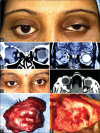Adenoid cystic carcinoma of the lacrimal gland - A major review
- PMID: 40995894
- PMCID: PMC12507167
- DOI: 10.4103/IJO.IJO_2560_24
Adenoid cystic carcinoma of the lacrimal gland - A major review
Abstract
Adenoid cystic carcinoma (ACC) of the lacrimal gland is a rare orbital neoplasm. Despite this, it remains the most common epithelial malignancy of the lacrimal gland. It is notorious for high rates of local recurrence, metastases, and mortality despite aggressive management. The treatment protocols range from orbital exenteration or an excision biopsy followed by adjuvant therapy in the form of radiotherapy or chemotherapy or sometimes both. Older studies suggest that orbital exenteration may result in better local control of disease and possibly better long-term survival. This outlook has been challenged by recent studies which suggest multimodal treatment combining various treatment strategies aiming for globe salvage and better disease-free survival. The present review analyzes in detail the various clinical and histopathological features, staging of the disease, management modalities, and treatment outcomes of ACC of the lacrimal gland published over the past 30 years.
Keywords: Adenoid cystic carcinoma; chemotherapy; exenteration; lacrimal gland; radiotherapy.
Copyright © 2025 Indian Journal of Ophthalmology.
Conflict of interest statement
There are no conflicts of interest.
Figures









References
-
- Ahmad SM, Esmaeli B, Williams M, Nguyen J, Fay A, Woog J, et al. American Joint Committee on Cancer classification predicts outcome of cases with lacrimal gland adenoid cystic carcinoma. Ophthalmology. 2009;116:1210–5. - PubMed
-
- Font RL, Smith SL, Bryan RG. Malignant epithelial tumors of the lacrimal gland: A clinicopathologic study of 21 cases. Arch Ophthalmol. 1998;116:613–6. - PubMed
Publication types
MeSH terms
LinkOut - more resources
Full Text Sources
Medical
Miscellaneous

